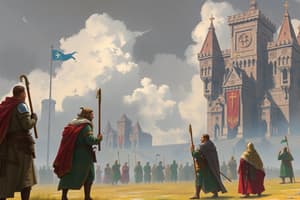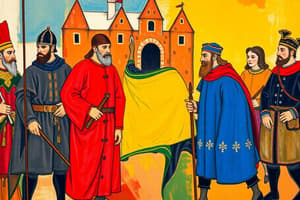Podcast
Questions and Answers
Who is at the top of the feudalism pyramid?
Who is at the top of the feudalism pyramid?
- Peasants/Serfs
- Knights
- Lords/Nobles
- King/Monarchs (correct)
Who is second from the top in the feudalism pyramid?
Who is second from the top in the feudalism pyramid?
Lords/Nobles
What role did the Knights play in feudalism?
What role did the Knights play in feudalism?
Mounted soldiers loyal to the king
Match the following roles with their responsibilities:
Match the following roles with their responsibilities:
Peasants paid taxes to the Lords in order to receive shelter and protection.
Peasants paid taxes to the Lords in order to receive shelter and protection.
The Knights received _______ from the nobles/lords.
The Knights received _______ from the nobles/lords.
What did the Nobles receive from the Kings?
What did the Nobles receive from the Kings?
The king owned all the land, and gave away _______ to nobles and lords.
The king owned all the land, and gave away _______ to nobles and lords.
Flashcards are hidden until you start studying
Study Notes
Feudalism Structure
- The feudal system is represented as a pyramid, delineating different social classes and their roles.
- Kings and monarchs sit at the top of the pyramid, ensuring order and providing protection to the entire feudal structure.
Lords and Nobles
- Lords and nobles are positioned just below the kings in the hierarchy.
- They manage manors, defend estates, and serve as local judges, playing essential roles in governance and law enforcement.
Knights
- Knights, located in the third tier, are mounted soldiers sworn to loyalty to the king.
- They receive land, known as fiefs, from nobles in exchange for military service and protection during conflicts.
Peasants and Serfs
- Peasants and serfs occupy the bottom of the pyramid, working primarily on farms to cultivate crops and rear livestock.
- Some peasants also hold specialized trades, such as carpentry or shoemaking, contributing to local economies.
Economic Obligations
- Peasants pay taxes to lords in exchange for shelter and protection, establishing a reciprocal relationship within feudal society.
- The king controls all land within the feudal system, distributing fiefs to nobles based on their loyalty and service.
Loyalty and Land
- Nobles pledge loyalty to the king as part of their agreement to receive fiefs, ensuring stability within the realm.
- The exchange of land for loyalty forms the cornerstone of feudal relationships, establishing a network of obligations among various classes.
Studying That Suits You
Use AI to generate personalized quizzes and flashcards to suit your learning preferences.




